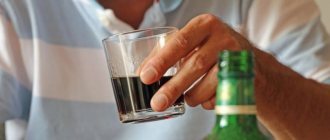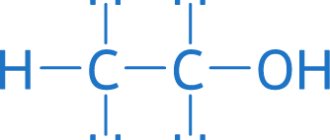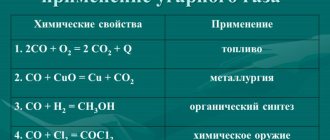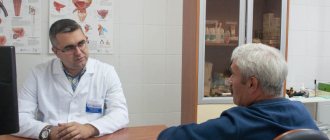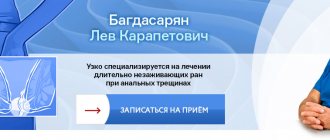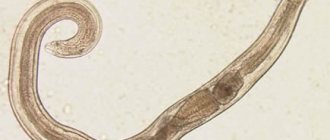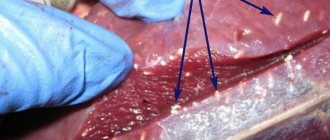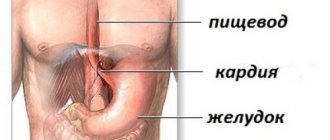Food poisoning is a pathological condition that occurs as a result of consuming low-quality, spoiled foods contaminated with pathogenic microorganisms and their waste products. The disease is not contagious, which means it is not transmitted from one person to another.
Most often, poisoning is caused by bacteria of the E. coli group, clostridia, staphylococci and salmonella.
Main symptoms of poisoning
When poisoned food enters the body, toxins enter the intestines, and from there through the mucous membrane they penetrate into the systemic bloodstream, causing clinical manifestations. The following symptoms are observed for food poisoning:
- Dyspeptic syndrome (nausea, vomiting, diarrhea).
- Weakness, malaise, decreased performance.
- Paleness of the skin.
- Increased heart rate and respiratory movements.
- Reduced blood pressure.
- Pain in the abdominal area.
- Increased body temperature.
In severe cases, the development of visual disturbances, the appearance of hallucinations and disturbances of consciousness (stupor, stupor, coma) are possible. If emergency assistance is not provided to the patient in such a situation, death is possible.
2.How can harmful microbes get into food?
- During meat processing. There are bacteria in the intestines of animals that humans use as food. This is normal, but sometimes bacteria also get on those parts of animals (meat) that we eat.
- Because of the water that is used to water or wash fruits and vegetables. If there are microbes in this water (most often these are microbes from animal manure and household wastewater), they can transfer to the food.
- While cooking. If items that have germs on them come into contact with food, the germs can be transferred to them. For example, if you use the same cutting board to cut vegetables and raw meat, germs can transfer to the vegetables. The same thing happens if you don’t wash your hands well after cutting meat.
Visit our Therapy page
First aid for poisoning
Providing emergency assistance for food poisoning is an extremely important event. This way you will cope with the disease faster and avoid complications.
Algorithm:
- Stomach cleansing. To do this, you need to drink a warm, weak solution of soda or potassium permanganate in a volume of 500 ml, and then induce vomiting. The procedure should be repeated until the wash water is clear.
- Taking sorbents (activated carbon, Filtrum) and enveloping drugs (Almagel).
- Drink plenty of fluids (clean water, warm tea, fruit infusions).
- Peace. The patient must be given a comfortable position in bed and ensure maximum comfort.
During the first day of illness, you should refrain from eating. Only drinking is allowed. Starting from the second day, you can start feeding the patient with vegetable soups and weak broths. When symptoms subside, the diet should be expanded, excluding fatty, smoked and salty foods from the menu. Carbonated drinks and coffee are also contraindicated.
3.How do you know if you have food poisoning?
Since most poisonings are quite easily tolerated, people do not always turn to doctors about this. Usually the assumption of food poisoning is made if people who eat the same food get sick at the same time.
If the symptoms of poisoning are severe enough - there is severe vomiting or diarrhea
, or your health condition does not improve within a few days, it is better to consult a doctor. The doctor will be able to accurately determine the cause of the illness and say whether it is really poisoning. You may need to do blood and stool tests for an accurate diagnosis.
About our clinic Chistye Prudy metro station Medintercom page!
Treatment
Treatment of food poisoning must be comprehensive. To do this, you must follow a strict diet and take the necessary medications. You can also turn to traditional methods.
Medications:
- Activated carbon (relieves symptoms of intoxication, relieves nausea).
- Enterosgel (adsorbs toxic substances and promotes their removal from the body).
- Rehydrog (a drug for preparing a water-salt solution necessary to combat dehydration).
- Linex (normalizes the functioning of intestinal microflora).
In severe cases, it is possible to take antibacterial drugs, but they must be prescribed by a specialist.
Folk remedies are also successfully used to treat food poisoning. The most commonly used decoctions are dill with honey, wormwood, marshmallow roots, yarrow, cinnamon tincture and ginger tea.
The diet involves fasting on the first day of illness. Then you should gradually introduce oatmeal in water, boiled, pureed vegetables, weak fish and meat broths, crackers, and lean meat into the diet. Drinks allowed include dried fruit compotes, herbal teas, jelly, fruit drinks, and boiled water.
Until complete recovery, you should exclude pickles, spices, fatty and fried foods, mushrooms, sweets and various sauces from your diet.
Prevention of disease.
In order to protect yourself from food poisoning, you must follow basic rules of personal hygiene: wash your hands before eating, handle food before eating and observe shelf life.
It is important to pay attention to the smell, taste, and condition of food and throw it away immediately if it has spoiled or become moldy. Food poisoning can often be caused by products containing cow's milk.
Besides:
- Avoid eating unknown, damaged or expired products;
- Store canned food in metal containers for no more than two years; Do not buy canned food in a dented jar without a label.
- Do not eat mushrooms, collected yourself or purchased at the market.
It is equally important to maintain hygiene when preparing and eating food. The kitchen and cooking equipment must be kept clean. Products must be thoroughly cooked.
Etiology and pathogenesis
The therapeutic effect of tricyclic antidepressants is: increased serotonin levels, inhibition of monoamine reuptake at synapses, antagonism of postsynaptic serotonin receptors.
Effects and symptoms
Pharmacological properties of TCAs that provide clinical results in overdose:
· Inhibition of monoamine reuptake (norepinephrine, serotonin).
· Sympathomimetic effects: arrhythmia myoclonus, muscle rigidity and hyperreflexia.
· Anticholinergic effects. Main symptoms range from elation to delirium, hallucinations, slurred speech, ataxia, sedation and coma.
· Peripheral effects cause dilated pupils, blurred vision, tachycardia, decreased oral and bronchial secretions, dry skin, urinary retention, increased muscle tone and tremor.
· Inhibition of adrenergic receptors. Hypotension and reflex tachycardia.
· Miosis, but pupil dilation may also develop.
· Sodium and potassium blockade. Increased PR, QRS and QT intervals.
· GABA antagonistic effect.
· Reduced seizure threshold.
Benzodiazepines and barbiturates are potent GABA receptor antagonists and are the first choice in the treatment of TCA-induced seizures.
Acidosis aggravates poisoning by increasing the concentration of tricyclic antidepressants and the direct effect of arrhythmia.
Sinus tachycardia and extrasystoles are the first cardiac symptoms. Gradually, the central inhibitory and cardiotoxic effects will dominate with sedation, bradyarrhythmia and hypotension.
Pharmacokinetics
· Tricyclic antidepressants are lipophilic drugs that easily penetrate the blood-brain barrier.
· At therapeutic doses, peak plasma levels are achieved within 2-6 hours.
· Tissue levels of TCA are typically 10-100 times higher than plasma concentrations (1-2% of body TCA found in blood). This means that hemodialysis or increased diuresis has only a minor effect.
· The average half-life of tricyclic antidepressants is 24 hours (ranges from 6 to 36 hours), but can be extended to 72 hours by overdose.
· The therapeutic dose is usually 2-4 mg/kg body weight. Doses exceeding this may have toxic effects. Life-threatening toxicity is often observed after ingestion of >15-20 mg/kg body weight.
Predisposing factors for poisoning are suicide attempts in patients with depression or unintentional drug poisoning.
Diagnostics
Diagnostic criteria
Poisoning with tricyclic antidepressants can be suspected based on the following conditions:
· Known to consume a toxic dose of a tricyclic drug.
· High concentration of TCA in the blood was detected.
NOTE: The large volume of distribution and serum values provide little information about the extent of toxicity and diagnosis is best made in the clinic.
History taking
To compile a detailed medical history, you need to ask a number of questions:
- How many tablets were taken? What type of preparation? Gastroresistant?
- When did the reception take place? Was the drug taken all at once or in parts?
- What specific drug was used and who gave the prescription?
- Do other people have access to the drug?
- Has the patient also taken alcohol, drugs, or other pills?
- Did the patient vomit? Were there any attempts to induce vomiting?
- Was activated carbon or another sorbent used?
- Circumstances of admission: depression, suicide attempts, accident?
Clinical data
Check vital signs and anticholinergic effects of tricyclic antidepressants:
· Decreased consciousness.
· Dilated pupils.
· Dry warm skin and general hyperthermia.
· Tachycardia.
· Thirst and dry mouth.
· Urinary retention and decreased intestinal motility (decreased bowel sounds).
· Delusions and hallucinations.
· More serious findings: arrhythmias (most serious bradyarrhythmias), hypotension, seizures, coma.
Other studies
Follow-up examinations of the patient's health status are carried out in the hospital:
· Basic acid state (blood gases).
· Serum electrolytes: creatinine, glucose.
· Electrocardiogram. Low voltage T waves, possibly inverted T waves, ST depression, widened QT interval, increased height of U waves, increased width P waves with notches. A widespread QRS complex indicates the severity of the condition. A QRS complex lasting more than 100 ms is often an indicator of cardiotoxic effects: severe arrhythmia and heart block, ventricular tachycardia and fibrillation. Less severe arrhythmias may also occur as sinus b adycardia, sinus arrest, or sinoatrial block.
· A chest x-ray is performed if there is decreased consciousness and suspicion of aspiration pneumonia.
In case of suspected overdose of tricyclic antidepressants, the patient should be immediately hospitalized and examined for the degree of poisoning.
Pathogens of food poisoning
The main bacteria whose toxins can cause foodborne illnesses are:
- Staphylococcus aureus – Staphylococcus aureus. Produces a toxin that affects the intestines. Widely distributed in the environment, it is well preserved and multiplies in food products, which provide a nutrient medium for it. In order not to create favorable conditions for the growth of bacteria and the production of toxins, prepared food should not be stored at room temperature for more than two hours. This is especially true for products with mayonnaise, protein or butter cream, meat and fish, minced meat products, dishes containing eggs, milk and other dairy products, soups.
- Bacillus cereus. Produces enterotoxin and emetic toxin. The disease is usually associated with eating rice dishes (raw rice is often contaminated with Bacillus cereus). The pathogen multiplies in dishes left after cooking at room temperature. Bacillus cereus toxin is heat stable, and repeated boiling of the dish does not destroy it.
- Clostridium perfringens. This foodborne toxic infection is associated with the consumption of undercooked meat, poultry and legumes. The disease usually lasts no more than a day and goes away without treatment.
- Salmonella Salmonella is an extremely resilient microorganism that survives in the external environment for quite a long time. Withstanding freezing, salmonella poses a danger to the body at the stage of defrosting meat, when dishes and sinks become contaminated with thawed bacteria.
